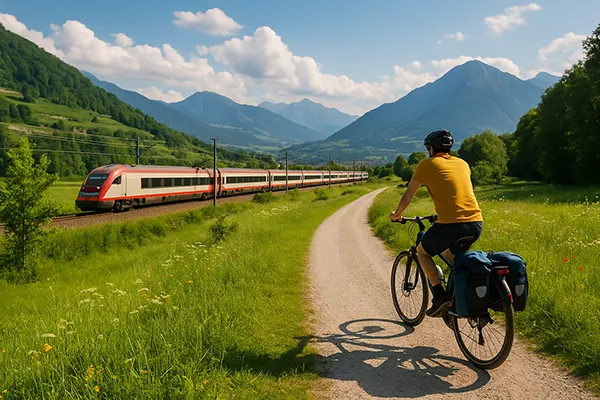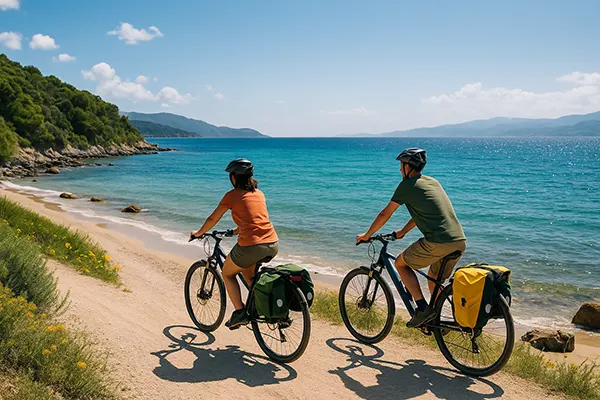
Green Routes of Europe: How to Travel Sustainably in 2025
As environmental awareness grows across Europe, more travellers are looking for alternatives that reduce their carbon footprint without sacrificing cultural and scenic experiences. In 2025, eco-tourism is shaping the way people move across the continent, with a clear emphasis on sustainable transport, low-impact exploration, and meaningful engagement with nature. From cross-country train journeys to extensive cycling networks, Europe is becoming a pioneer in sustainable travel practices.
Travelling by Train Instead of Flying
Rail travel has taken centre stage in Europe’s eco-tourism landscape. Countries such as France, Germany, and Austria have invested heavily in high-speed and overnight trains, allowing passengers to cover long distances quickly and comfortably. The introduction of new sleeper routes, such as Berlin to Barcelona, provides travellers with an efficient and environmentally friendly way to journey across the continent.
According to the European Environment Agency, train travel emits up to 90% less CO₂ per passenger compared to flying the same route. Governments are encouraging this shift by banning short-haul flights where viable train alternatives exist. For instance, France has already introduced restrictions on certain domestic air routes, and other nations are expected to follow suit in 2025.
Beyond the environmental benefits, rail journeys also provide opportunities for cultural immersion. Travellers can enjoy local landscapes, stop in lesser-known towns, and experience a slower, more authentic form of exploration that air travel simply cannot offer.
Night Trains and New Routes
Night trains have seen a remarkable revival across Europe. Operators such as ÖBB’s Nightjet, European Sleeper, and Midnight Trains are expanding their networks in 2025, connecting cities like Brussels, Prague, and Lisbon. These services combine sustainability with convenience, as travellers can sleep on board and wake up in a new destination, eliminating the need for hotel stays while cutting emissions.
The affordability of night trains has also improved, with governments offering subsidies and discount passes for young travellers. Digital booking platforms now make it easy to compare routes and schedules, encouraging more people to choose this greener option.
This renewed interest in sleeper trains represents a cultural shift towards valuing time-rich travel experiences that prioritise both sustainability and comfort.
The Rise of Cycling Tourism
Cycling tourism has gained momentum in Europe, with thousands of kilometres of dedicated routes developed for both short and long-distance journeys. Networks such as EuroVelo, which spans over 90,000 km, have become the backbone of sustainable adventure tourism in 2025. From the Baltic Sea to the Mediterranean, cyclists can now traverse entire regions with reliable infrastructure and clear signage.
Many European cities, including Amsterdam, Copenhagen, and Vienna, are continually improving their cycling infrastructure, integrating it with public transport for seamless travel. The combination of local bike rentals, e-bike availability, and improved road safety regulations makes cycling more accessible to a wider audience, including families and older travellers.
Cycling not only reduces carbon emissions but also promotes health and wellness. Travellers who choose bicycles as their main mode of transport benefit from a slower pace that allows them to engage more deeply with local landscapes and communities.
Eco-Friendly Bike Routes
Some of the most popular eco-friendly cycling routes in 2025 include the Danube Cycle Path, the Loire Valley trails in France, and the North Sea Cycle Route. These journeys combine breathtaking scenery with opportunities to visit UNESCO heritage sites, national parks, and rural villages that often remain untouched by mass tourism.
Electric bike technology has expanded the possibilities of long-distance cycling, enabling more people to take on routes that were previously too demanding. Charging stations are now widely available along major cycling paths, ensuring smooth travel even in remote areas.
European tourism boards are promoting these routes as part of broader sustainability campaigns, emphasising the role of cycling in achieving climate goals and encouraging responsible travel.

Green Tourism Initiatives Across Europe
Beyond trains and bicycles, European governments and organisations are launching initiatives to encourage eco-friendly tourism. Many cities are introducing low-emission zones, expanding public transport, and providing incentives for travellers who choose sustainable options. Accommodation providers are also adopting stricter environmental standards, from renewable energy use to waste reduction programmes.
In 2025, eco-certifications such as the EU Ecolabel have become more widespread, helping travellers identify hotels and services that adhere to sustainability principles. These initiatives not only benefit the environment but also strengthen local economies by supporting small businesses and community-based tourism projects.
Events such as the European Green Travel Summit highlight best practices and encourage collaboration between countries to develop continent-wide standards for eco-tourism. This shared effort is positioning Europe as a global leader in sustainable travel.
Future of Sustainable Travel in Europe
Looking ahead, technological innovation will further enhance Europe’s green travel network. Hydrogen-powered trains, expanded e-bike sharing systems, and improved smart ticketing solutions are already being piloted in several countries. These advancements aim to make eco-friendly travel not just a choice but the most convenient and attractive option.
As climate concerns intensify, the push for sustainable tourism is likely to accelerate. Travellers in 2025 have access to more responsible choices than ever before, supported by governments, local communities, and industry leaders. The result is a travel landscape where sustainability is no longer an alternative but an essential standard.
Ultimately, Europe’s green routes represent a model for the rest of the world, showing how eco-tourism can thrive while preserving cultural and natural heritage for future generations.
